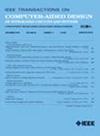提高基于互补场效应晶体管的逆变器交流性能的器件设计指南
IF 2.9
3区 计算机科学
Q2 COMPUTER SCIENCE, HARDWARE & ARCHITECTURE
IEEE Transactions on Computer-Aided Design of Integrated Circuits and Systems
Pub Date : 2025-02-05
DOI:10.1109/TCAD.2025.3539599
引用次数: 0
摘要
互补场效应晶体管(cfet)已成为下一代半导体器件的有希望的候选者。cfet的特点是底部有一个nMOS(或pMOS)晶体管,顶部有一个相反类型的晶体管。根据通道结构的不同,CFETs可分为Fin-CFETs和GAA-CFETs。在本研究中,我们对这两种器件进行了比较和分析,以确定哪种结构更有利于器件扩展,哪种器件在单位面积上具有更好的性能。为了进行可靠的分析,将阈值电压调整为所有器件的相同电压。首先,为了比较直流性能,从$I_{\mathrm {DS}}$ -和- $V_{\mathrm {GS}}$输入转移特性中提取线性模式和饱和模式下的导通状态驱动电流并进行比较。随后,构建互补金属-氧化物-半导体逆变器,比较其交流性能。提取并比较了6个参数:高到低传播延迟($t_{pLH}$)、下降时间($t_{f}$)、低到高传播延迟($t_{pLH}$)、上升时间($t_{r}$)、过调电压($V_{ov}$)和欠调电压($V_{und}$)。在此基础上,我们提出了哪种结构更适合器件缩放。本文章由计算机程序翻译,如有差异,请以英文原文为准。
Device Design Guidelines to Boost Up AC Performance of CFET (Complementary Field-Effect-Transistor)-Based Inverter
Complementary field-effect transistors (CFETs) have emerged as promising candidates for next-generation semiconductor devices. CFETs feature a structure with an nMOS (or pMOS) transistor at the bottom and a transistor of the opposite type at the top. CFETs can be classified into Fin-CFETs or GAA-CFETs based on their channel structure. In this study, we compare and analyze these two devices to determine which structure is more favorable for device scaling and which device exhibits better performance per unit area. For a reliable analysis, the threshold voltage was adjusted to be the same for all devices. Initially, to compare the DC performance, the on-state drive currents in both linear mode and saturation mode operations were extracted and compared from the $I_{\mathrm { DS}}$ -versus- $V_{\mathrm { GS}}$ input-transfer characteristics. Subsequently, complementary metal-oxide-semiconductor inverters were constructed to compare their AC performance. Six parameters were extracted and compared: high-to-low propagation delay ( $t_{pLH}$ ), falling time ( $t_{f}$ ), low-to-high propagation delay ( $t_{pLH}$ ), rising time ( $t_{r}$ ), overshoot voltage ( $V_{ov}$ ), and undershoot voltage ( $V_{und}$ ). Based on the results, we suggest which CFET structure is more suitable for device scaling.
求助全文
通过发布文献求助,成功后即可免费获取论文全文。
去求助
来源期刊
CiteScore
5.60
自引率
13.80%
发文量
500
审稿时长
7 months
期刊介绍:
The purpose of this Transactions is to publish papers of interest to individuals in the area of computer-aided design of integrated circuits and systems composed of analog, digital, mixed-signal, optical, or microwave components. The aids include methods, models, algorithms, and man-machine interfaces for system-level, physical and logical design including: planning, synthesis, partitioning, modeling, simulation, layout, verification, testing, hardware-software co-design and documentation of integrated circuit and system designs of all complexities. Design tools and techniques for evaluating and designing integrated circuits and systems for metrics such as performance, power, reliability, testability, and security are a focus.

 求助内容:
求助内容: 应助结果提醒方式:
应助结果提醒方式:


